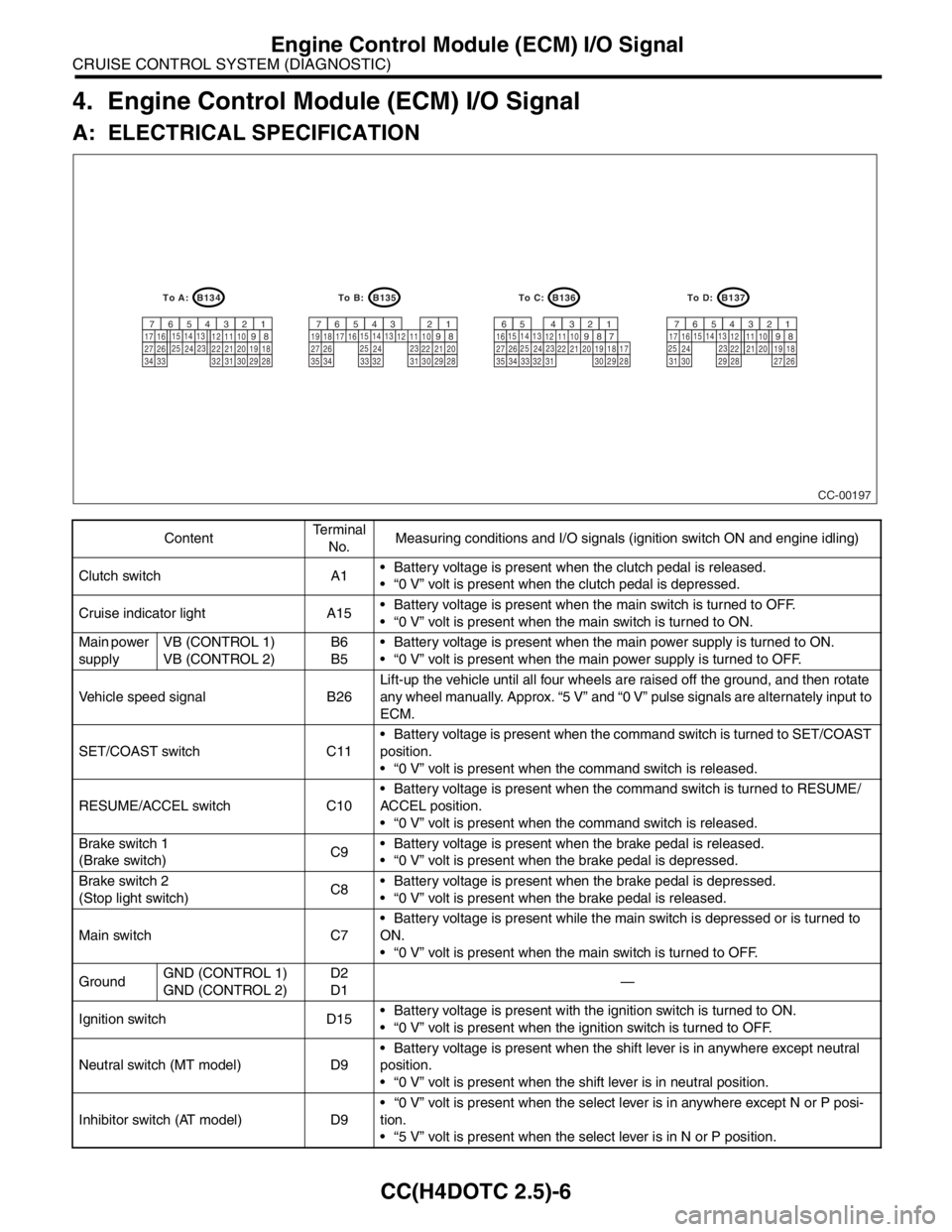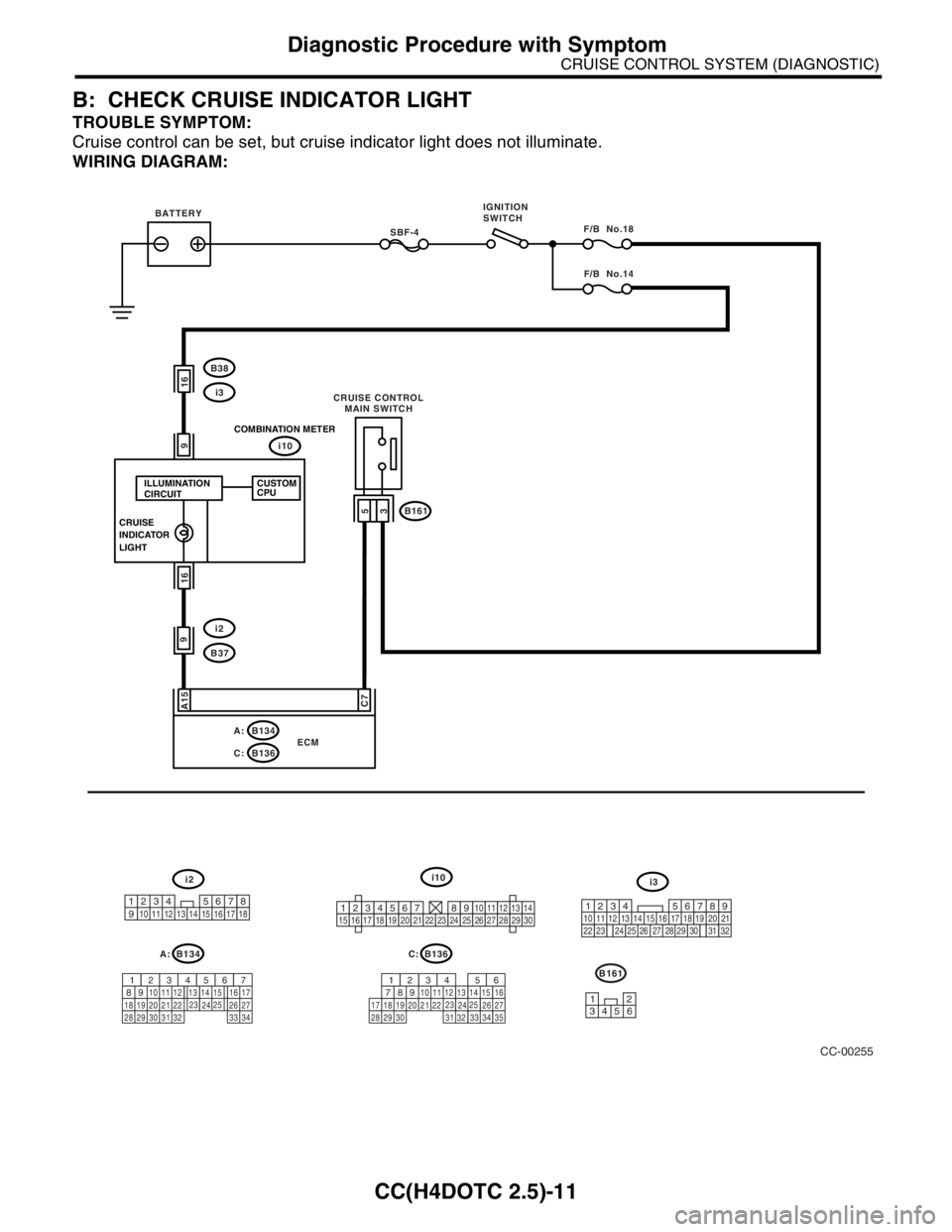2004 SUBARU FORESTER ignition
[x] Cancel search: ignitionPage 599 of 2870

CC(H4SO)-31
CRUISE CONTROL SYSTEM (DIAGNOSTIC)
Diagnostic Procedure with Diagnostic Trouble Code (DTC)
Step Check Yes No
1 CHECK TRANSMISSION TYPE.Is the target MT model? Go to step 2.Go to step 6.
2 CHECK HARNESS BETWEEN BATTERY
AND VEHICLE SPEED SENSOR.
1) Turn the ignition switch to OFF.
2) Disconnect the harness connector from
vehicle speed sensor.
3) Turn the ignition switch to ON.
4) Measure the voltage between vehicle
speed sensor harness connector terminal and
chassis ground.
Connector & terminal
(B17) No. 3 (+) — Chassis ground (
−):Is the voltage more than 10 V? Go to step 3.Check the harness
for open or short
between fuse relay
and vehicle speed
sensor.
3 CHECK HARNESS BETWEEN CRUISE CON-
TROL MODULE AND VEHICLE SPEED SEN-
SOR.
1) Turn the ignition switch to OFF.
2) Disconnect the harness connector from
cruise control module.
3) Measure the resistance between vehicle
speed sensor harness connector terminal and
cruise control module harness connector ter-
minal.
Connector & terminal
(B17) No. 1 — (B94) No. 19:Is the resistance less than 10
Ω?Go to step 4.Repair the har-
ness.
4 CHECK HARNESS BETWEEN VEHICLE
SPEED SENSOR AND ENGINE GROUND.
1) Turn the ignition switch to OFF.
2) Measure the resistance between vehicle
speed sensor harness connector terminal and
engine ground.
Connector & terminal
(B17) No. 2 — Engine ground:Is the resistance less than 10
Ω?Go to step 5.Repair the har-
ness.
5 CHECK VEHICLE SPEED SENSOR.
1) Connect the harness connector to vehicle
speed sensor.
2) Lift-up the vehicle and support with rigid
racks.
3) Drive the vehicle at speed greater than 20
km/h (12 MPH).
Warning:
Be careful not to be caught up by the run-
ning wheels.
4) Measure the voltage between cruise control
module harness connector terminal and chas-
sis ground.
Connector & terminal
(B94) No. 19 (+) — Chassis ground (
−):Is the voltage less than 0 V ←
→ more than 5 V?Replace the cruise
control module.
Module.>Replace the vehi-
cle speed sensor.
6 CHECK HARNESS BETWEEN CRUISE CON-
TROL MODULE AND TCM.
1) Turn the ignition switch to OFF.
2) Disconnect the harness connector from
TCM and cruise control module.
3) Measure the resistance between cruise
control module harness connector terminal
and TCM harness connector terminal.
Connector & terminal
(B94) No. 19 — (B56) No. 17:Is the resistance less than 10
Ω?Go to step 7.Repair the har-
ness.
Page 603 of 2870

CC(H4SO)-35
CRUISE CONTROL SYSTEM (DIAGNOSTIC)
Diagnostic Procedure with Diagnostic Trouble Code (DTC)
Step Check Yes No
1 CHECK POWER SUPPLY.
1) Turn the ignition switch to OFF.
2) Disconnect the harness connector from
cruise control actuator.
3) Turn the ignition switch to ON.
4) Turn the cruise control main switch to ON.
5) Measure the voltage between cruise control
actuator harness connector terminal and chas-
sis ground.
Te r m i n a l s
(B7) No. 4 (+) — Chassis ground (
−):Is the voltage more than 10 V? Go to step 2.Check the harness
for open or short
between cruise
control module
and cruise control
actuator.
2 CHECK GROUND CIRCUIT OF ACTUATOR.
1) Turn the ignition switch and cruise control
main switch to OFF.
2) Measure the resistance between cruise
control actuator harness connector terminal
and chassis ground.
Te r m i n a l s
(B7) No. 6 — Chassis ground:Is the resistance less than 10
Ω?Go to step 3.Repair the har-
ness.
3 MEASURE RESISTANCE OF ACTUATOR.
Measure the resistance of cruise control actua-
tor motor.
Te r m i n a l s
No. 4 — No. 1:
No. 4 — No. 2:
No. 4 — No. 5:Is the resistance approx. 5 Ω? Go to step 4.Replace the cruise
control actuator.
4 CHECK HARNESS BETWEEN ACTUATOR
AND CRUISE CONTROL MODULE.
1) Disconnect the harness connector from
cruise control module.
2) Measure the resistance between cruise
control module harness connector terminal
and cruise control actuator harness connector
terminal.
Connector & terminal
(B7) No. 1 — (B94) No. 7:Is the resistance less than 10
Ω?Go to step 5.Repair the har-
ness.
5 CHECK HARNESS BETWEEN ACTUATOR
AND CRUISE CONTROL MODULE.
Measure the resistance between cruise control
module harness connector terminal and cruise
control actuator harness connector terminal.
Connector & terminal
(B7) No. 5 — (B94) No. 5:Is the resistance less than 10
Ω?Replace the cruise
control module.
Module.>Repair the har-
ness.
Page 605 of 2870

CC(H4SO)-37
CRUISE CONTROL SYSTEM (DIAGNOSTIC)
Diagnostic Procedure with Diagnostic Trouble Code (DTC)
Step Check Yes No
1 CHECK POWER SUPPLY.
1) Turn the ignition switch to OFF.
2) Disconnect the harness connector from
cruise control actuator.
3) Turn the ignition switch to ON.
4) Turn the cruise control main switch to ON.
5) Measure the voltage between cruise control
actuator harness connector terminal and chas-
sis ground.
Te r m i n a l s
(B7) No. 4 (+) — Chassis ground (
−):Is the voltage more than 10 V? Go to step 2.Check the harness
for open or short
between cruise
control module
and cruise control
actuator.
2 CHECK GROUND CIRCUIT OF ACTUATOR.
1) Turn the ignition switch and cruise control
main switch to OFF.
2) Measure the resistance between cruise
control actuator harness connector terminal
and chassis ground.
Te r m i n a l s
(B7) No. 6 — Chassis ground:Is the resistance less than 10
Ω?Go to step 3.Repair the har-
ness.
3 MEASURE RESISTANCE OF ACTUATOR
CLUTCH.
Measure the resistance of cruise control actua-
tor clutch.
Te r m i n a l s
No. 3 — No. 6:Is the resistance approx. 39 Ω? Go to step 4.Replace the cruise
control actuator.
4 CHECK HARNESS BETWEEN ACTUATOR
AND CRUISE CONTROL MODULE.
1) Disconnect the harness connector from
cruise control module.
2) Measure the resistance between cruise
control module harness connector terminal
and cruise control actuator harness connector
terminal.
Connector & terminal
(B7) No. 2 — (B94) No. 13:Is the resistance less than 10
Ω?Go to step 5.Repair the har-
ness.
5 CHECK HARNESS BETWEEN ACTUATOR
AND CRUISE CONTROL MODULE.
Measure the resistance between cruise control
module harness connector terminal and cruise
control actuator harness connector terminal.
Connector & terminal
(B7) No. 3 — (B94) No. 14:Is the resistance less than 10
Ω?Replace the cruise
control module.
Module.>Repair the har-
ness.
Page 606 of 2870

CC(H4SO)-38
CRUISE CONTROL SYSTEM (DIAGNOSTIC)
Diagnostic Procedure with Diagnostic Trouble Code (DTC)
F: DTC 38 MOTOR DRIVE SHAFT DOES NOT ENGAGE PROPERLY.
G: DTC 39 MOTOR IS OVERLOADED.
Step Check Yes No
1 CHECK ACTUATOR MOTOR.
1) Turn the ignition switch to OFF.
2) Disconnect the harness connector from
cruise control actuator.
3) Remove the cruise control actuator from
mounting bracket.
4) Pull the cable by hand to check for loose-
ness or status of inner gear engagement.Are foreign particles caught in
the inner gear or does inner
gear engage and disengage
improperly?Replace the cruise
control actuator.
control cable
adjustment.
CABLE FREE
PLAY, INSPEC-
TION, General
Description.>
Step Check Yes No
1 CHECK THE OPERATING CURRENT TO AC-
TUATOR MOTOR.
1) Connect the Subaru Select Monitor to data
link connector.
2) Try to drive the vehicle while operating the
cruise control system.
3) Measure the operation current to the cruise
control actuator motor.
Connector & terminal
(B7) No. 4 — Chassis ground:Is the voltage more than 10 A? Replace the cruise
control module.
Module.>Check the power
supply circuit.
CHECK POWER
SUPPLY, Diagnos-
tic Procedure with
Symptom.>
Page 618 of 2870

CC(H4DOTC 2.5)-6
CRUISE CONTROL SYSTEM (DIAGNOSTIC)
Engine Control Module (ECM) I/O Signal
4. Engine Control Module (ECM) I/O Signal
A: ELECTRICAL SPECIFICATION
ContentTe r m i n a l
No.Measuring conditions and I/O signals (ignition switch ON and engine idling)
Clutch switch A1 Battery voltage is present when the clutch pedal is released.
“0 V” volt is present when the clutch pedal is depressed.
Cruise indicator light A15 Battery voltage is present when the main switch is turned to OFF.
“0 V” volt is present when the main switch is turned to ON.
Main power
supplyVB (CONTROL 1)
VB (CONTROL 2)B6
B5 Battery voltage is present when the main power supply is turned to ON.
“0 V” volt is present when the main power supply is turned to OFF.
Vehicle speed signal B26Lift-up the vehicle until all four wheels are raised off the ground, and then rotate
any wheel manually. Approx. “5 V” and “0 V” pulse signals are alternately input to
ECM.
SET/COAST switch C11 Battery voltage is present when the command switch is turned to SET/COAST
position.
“0 V” volt is present when the command switch is released.
RESUME/ACCEL switch C10 Battery voltage is present when the command switch is turned to RESUME/
ACCEL position.
“0 V” volt is present when the command switch is released.
Brake switch 1
(Brake switch)C9 Battery voltage is present when the brake pedal is released.
“0 V” volt is present when the brake pedal is depressed.
Brake switch 2
(Stop light switch)C8 Battery voltage is present when the brake pedal is depressed.
“0 V” volt is present when the brake pedal is released.
Main switch C7 Battery voltage is present while the main switch is depressed or is turned to
ON.
“0 V” volt is present when the main switch is turned to OFF.
GroundGND (CONTROL 1)
GND (CONTROL 2)D2
D1—
Ignition switch D15 Battery voltage is present with the ignition switch is turned to ON.
“0 V” volt is present when the ignition switch is turned to OFF.
Neutral switch (MT model) D9 Battery voltage is present when the shift lever is in anywhere except neutral
position.
“0 V” volt is present when the shift lever is in neutral position.
Inhibitor switch (AT model) D9 “0 V” volt is present when the select lever is in anywhere except N or P posi-
tion.
“5 V” volt is present when the select lever is in N or P position.
CC-00197
B134
9
30 29 28 32 3120 19 18 22 2110 12 1114
24
34 3327 2617 16123456713
23 15
258
B135
9
30 29 28
323120 22 2110 12 1114
24
35
3327 2617 16123456713
23 15
258
B136
9
30 29 28
32 3120 19 18 22 2110 12 1114
24
34 3327 261612345613
23 15
258
B137
9
29 2820 19 18 22
2110 12
1114
2417 16123456713
23 15
2581819
34
7173530 3127 26
To D: To C: To B: To A:
Page 621 of 2870

CC(H4DOTC 2.5)-9
CRUISE CONTROL SYSTEM (DIAGNOSTIC)
Subaru Select Monitor
9) If the cruise speed is canceled itself (without do-
ing any cancel operations), DTC will appear on se-
lect monitor display after {Cancel Code(s) Display}
is selected on the Engine Diagnosis display screen
and [YES] key is pressed.
CAUTION:
DTC will also appear when cruise cancel is ef-
fected by driver. Do not confuse.
Have a co-worker ride in the vehicle to assist
in diagnosis during driving.
NOTE:
DTC will be cleared by turning the ignition switch or
cruise control main switch to OFF.
3. REAL-TIME DIAGNOSIS
1) Connect the select monitor.
2) Turn the ignition switch and cruise control main
switch to ON.
3) Turn the Subaru Select Monitor switch to ON.
4) On the «Main Menu» display screen, select the
{2. Each System Check} and press [YES] key.
5) On the «System Selection» display screen, se-
lect the {Engine} and press [YES] key.
6) Press the [YES] key after the information of en-
gine type displayed.
7) On the «Engine Diagnosis» display screen, se-
lect the {Current Data Display & Save} and press
[YES] key.
8) Make sure that normal indication is displayed
when controls are operated as indicated below:
Depress/release the brake pedal. (Stop light
switch and brake switch turn ON.)
Turn ON the “SET/COAST” switch.
Turn ON the “RESUME/ACCEL” switch.
Turn ON the “CANCEL” switch. (The “SET/
COAST” and “RESUME/ACCEL” switch are turned
ON at same time.)
Depress/release the clutch pedal.
Set the shift lever to except for neutral position.
NOTE:
For detailed operation procedure, refer to the “SUB-
ARU SELECT MONITOR OPERATION MANUAL.”
For details concerning DTCs, refer to the “List of
Diagnostic Trouble Code (DTC).”
Code (DTC).>
Page 623 of 2870

CC(H4DOTC 2.5)-11
CRUISE CONTROL SYSTEM (DIAGNOSTIC)
Diagnostic Procedure with Symptom
B: CHECK CRUISE INDICATOR LIGHT
TROUBLE SYMPTOM:
Cruise control can be set, but cruise indicator light does not illuminate.
WIRING DIAGRAM:
CC-00255
i10i3
123456789101112131415161718192021222324252627282930
B134
9
30 29 28 323120 19 18 222110 121114
24
34 3327 2617 16123456713
2315
258
B136
9
30 29 28 323120 19 18 22211012
1114
24
34 3327
261612345613
2315
25871735
C: A:
B161
219
32
1234
5610 11 12 13 14 15716
23 3019 20
22 26 27 28 29817
24 3118
25
COMBINATION METERSBF-4F/B No.18
B38
i3F/B No.14
16
BATTERYIGNITION
SWITCH
CRUISE CONTROL
MAIN SWITCH
ILLUMINATION
CIRCUIT
A15
C716
i2
B37
5
3B161
9 9i10
B134
A:
B136
C:ECM CRUISE
INDICATOR
LIGHTCUSTOM
CPU
12
3456
i2
123 8
910411 12 13 14 15 165671718
Page 624 of 2870

CC(H4DOTC 2.5)-12
CRUISE CONTROL SYSTEM (DIAGNOSTIC)
Diagnostic Procedure with Symptom
Step Check Yes No
1 CHECK CRUISE INDICATOR LIGHT CIR-
CUIT.
1) Turn the ignition switch to OFF.
2) Disconnect the combination meter harness
connector.
3) Turn the ignition switch to ON.
4) Measure the voltage between harness con-
nector terminal and chassis ground.
Connector & terminal
(i10) No. 9 (+) — Chassis ground (
−):Is the voltage more than 10 V? Go to step 2. Check the fuse
No. 14 (in fuse &
relay box).
Check the har-
ness for open or
short between
combination meter
and fuse & relay
box.
2 CHECK CRUISE INDICATOR LIGHT CIR-
CUIT.
1) Turn the ignition switch to OFF.
2) Disconnect the ECM harness connector.
3) Measure the resistance between ECM har-
ness connector terminal and combination
meter harness connector terminal.
Connector & terminal
(B134) No. 15 — (i10) No. 16:Is the resistance less than 10
Ω?Go to step 3.Repair the har-
ness.
3 CHECK CRUISE INDICATOR LIGHT CIR-
CUIT.
Ground the ECM harness connector terminal
with a suitable wire.
Connector & terminal
(B134) No. 15 — Chassis ground:Does the cruise indicator light
illuminate?Check the poor
contact of ECM
connector.Replace the meter
main assembly.